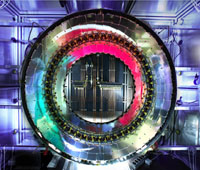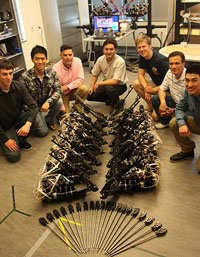Campus News
Year of the Slug: A look back at 2012 at UC Santa Cruz
Higgs boson, condors, pumas, the Grateful Dead Archive … 2012 was yet another year of discoveries, breakthroughs, newsmakers, and honors for UC Santa Cruz. Here’s a look back at a few highlights of the year at UCSC.






Higgs boson, condors, pumas, the Grateful Dead Archive … 2012 was yet another year of discoveries, breakthroughs, newsmakers, and honors for UC Santa Cruz. Here’s a look back at a few highlights of the year at UCSC.
Science and technology on the cutting edge
• UC Santa Cruz scientists helped organize an ambitious international ocean drilling expedition to measure properties of the fault that caused the Tohoku earthquake and tsunami, installing a new observatory beneath the seafloor at the site of the devastating earthquake.
• UCSC’s team of accomplished physicists were involved in experiments at the Large Hadron Collider that produced evidence of the long-sought Higgs boson, a key part of the theory that explains the masses of fundamental particles.
• UCSC astronomy and astrophysics professor Sandra Faber was one of a dozen researchers selected by President Obama to receive the National Medal of Science. Faber has made important contributions to scientific progress in understanding the history and structure of the universe.
• UCSC launched a large-scale data repository and user portal for the National Cancer Institute’s cancer genome research programs. Meanwhile, UCSC combined Rx with R2D2 when it exported its ‘open-source’ robotic surgery platforms to top medical research labs.
• UCSC alumnus Steve Collins of the Jet Propulsion Laboratory was seen in photographs around the world during news coverage of the dramatic landing of NASA’s robotic explorer Curiosity on the surface of Mars. Collins helped guide the explorer to a successful landing on August 5.
• UCSC’s cutting-edge research continued to influence the world. In fact, the campus ranked second in research influence as measured by the number of times its faculty’s published work is cited by scholars around the world.
A natural respect for wildlife
• A comprehensive study, led by UCSC researchers, confirmed that lead-based bullets are the primary source of lead in condors and showed that the condor population cannot recover as long as lead contamination persists.
• UCSC community members filled an auditorium on campus to learn about Chris Wilmers’s Santa Cruz Mountains Puma Project. Wilmers got laughs and a few relieved sighs when he remarked that Santa Cruzans have a better chance of getting hospitalized because of a run-in with their own toothbrushes than getting hurt by a mountain lion.
• In other creature news, a UCSC Ph.D. student looking at the spread of Lyme disease in the east linked it to a decline in foxes that feed on the small rodents that carry infected ticks. Previously, the carries were believed to be deer.
• There were also a few UCSC-related ‘aw’ moments in the natural realm. One of them was the discovery of four Peregrine falcon eggs in a nest on the PG&E headquarters building in San Francisco, captivating web watchers in the spring.
Treading lightly on the earth
• Pioneering UCSC faculty are addressing safer and healthier ways to grow food while treading more lightly on the earth. This year the Center for Agroecology and Sustainable Food Systems won two significant grants from the U.S. Department of Agriculture totaling more than $3.25 million to expand research into alternative methods of growing strawberries without pesticides and to teach and support new organic farmers.
Slugs, arts and letters
• Slugs also recognize the value of a genuine California cultural treasure. This year UCSC had a grand celebration to launch the Grateful Dead Archive, which represents one of the most significant popular cultural collections of the 20th Century. Many media outlets took notice, including the New Yorker.
• Slugs also told heir own stories in a highly public and prestigious realm this year. One of them, UCSC alumna Reyna Grande, received raves for a new memoir about immigration.
• UCSC tapped the director of the Frances Young Tang Teaching Museum and Art Gallery at Skidmore College to lead an innovative museum project, the Institute for Arts & Science. “The institute will be the first of its kind at a research university focusing on the relationship between the arts and sciences,“ noted David Yager, dean of the Arts Division at UC Santa Cruz.
• This year, UC Santa Cruz professor of Film and Digital Media B. Ruby Rich was awarded the 2012 Frameline Award at the 36th annual San Francisco International LGBT Film Festival, running June 14 to 24.
Slugs in high places
Meanwhile, Banana Slugs roamed the halls of power this year.
• Slugs also served other very high-profile advisory roles. Psychology and legal studies professor Craig Haney, a national expert on inmate mental health, told a U.S. Senate subcommittee in June that solitary confinement rates have soared since the 1970s and for many inmates the practice “precipitates a descent into madness.”
• UC Santa Cruz alumna Rachel Goslins, executive director of the President’s Committee on the Arts and the Humanities, serves on an advisory committee to the White House on cultural issues. “I get to work with the White House, policymakers at the highest level of government, the private sector, and our Committee members … all in service of supporting the essential role of culture and the arts and humanities in our country. What’s not to love?”
• UCSC professor Dana Frank added to the national dialogue about U.S. policy surrounding the new regime in Honduras by contributing a cover story to The Nation magazine, as well as an op-ed to the New York Times.